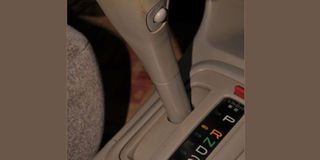Why is my TCS light on?

An automatic gear lever looks like this. PHOTO BY MICHEAL KAKUMIRIZI
I drive a Ford Telstar but it displays TCS on the dashboard even when I switch it off using its switch, the TCS light persists on the display. What could be the reason?
TCS stands for Traction Control System. This system is fitted on most modern vehicles and helps to reduce tyre or wheel slip during acceleration on loose or slippery surfaces. When a vehicle’s wheels slip it loses traction or the ability to move forward because it draws power from all the other wheels. TCS is an innovation that improved the function of the old ‘Limited Slip Differential’ system (LSD).
The TCS system employs sensors connected to the ABS (Anti-lock Braking System) to continuously monitor the speed of each wheel. If the system detects a wheel or set of wheels spinning faster than the others it automatically applies the brakes of that wheel or set of wheels. Some traction control systems reduce engine performance by inhibiting the spark or restricting fuel supply. This withholds power to the spinning wheels to allow the other wheels to restore balanced power and the driver to regain control of the vehicle. Usually this happens passively without the driver manually intervening.
On your Ford Telstar the TCS light should stay on for a few seconds when the ignition switch is turned to the ON position. The TCS light will flash briefly when the system is automatically engaged when you drive over a slippery surface. The “TCS OFF” light will illuminate when the driver disables the system by pressing the TCS OFF button.
The TCS system will have a malfunction if the “TCS” or “TCS OF” light remains illuminated even when you have not switched the system off or when the vehicle is not slipping. Failure of the TCS system may be caused by damaged or malfunctioning wheel speed sensors due to corrosion or damage of the sensor wire harness during suspension repairs or brake pad replacement.
TCS will also fail due to a malfunctioning TCS or ABS computer caused by water intrusion, corroded contacts or wrong jump
-----------------------
start procedure. You need to visit the Ford dealer or any garage of your choice equipped with a Ford computer diagnostic tool to quickly pinpoint the defective component for prompt repair.
Thank you very much for your help, especially understanding (O/D) overdrive use. Is it true that when O/D is on, the fuel consumption is high? Anyway you did not talk about fuel consumption when overdrive is off or on. What is the effect on the fuel consumption?
-----------------------
My car is VistaArdeo.
Justus
As I mentioned in last week’s article about overdrive, the O/D feature is similar to the fifth gear in a manual transmission car. O/D is the highest gear which will reduce the load on your engine and subsequently your fuel consumption. In other words your fuel economy improves. This is especially because you should use O/D on a highway. Your fuel economy statistics will vary depending on your vehicle condition and driving style. Not using O/D (O/D off as displayed on your dashboard) means your engine is loaded due to the lower choice of gears hence the higher fuel consumption.
-----------------------
Thanks for the good work in sharing technical information with us in handling vehicles. When is it necessary to apply the “L” or “2” gears marked on the automatic vehicles?
Martin Kiiza
The “D2” and “L” gears on your automatic transmission are used to slow down your car by restricting your automatic transmission to a lower gear. This feature is designed to help a motorist maintain traction of the car when driving in bad weather or down steep terrain.
Drive “2” when selected will be useful to maintain sufficient engine torque (pulling power) when driving on a wet slippery road or during the towing of another vehicle. “L” should be selected when the car is stuck in a rut or slippery ditch or when you need to slow down the car when driving down a steep incline. If you are a skillful performance driver and you want to delay gear upshifts to gain momentum you can start driving with position “L” selected and shift slowly upwards to “D2” and finally to “D” Drive for normal automatic gear shifts.
Whereas this gear shift procedure gives you more take-off power it will cost you more fuel. When driving at speeds beyond 20kph you should not downshift from D (Drive) to D2 or L as this will cause serious damage to your transmission.




